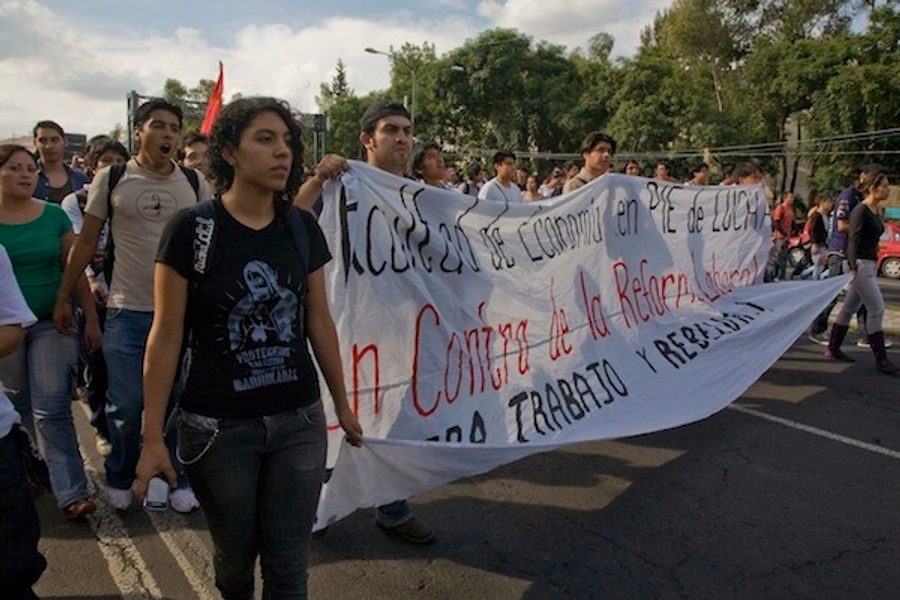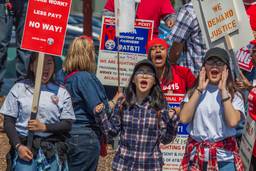Mexico’s Labor Law Reform Sparks Massive Protests
A plan to gut labor protections has spurred unrest in Mexico’s streets.
David Bacon

MEXICO CITY — As the Mexican Senate tried to convene last week, unionists, youth protesters from the #YoSoy132 movement and social activists of every stripe blocked the chamber’s doors, trying to prevent legislators from meeting to consider the reforma laboral. On October 2, tens of thousands marched from the Tlatelolco (Plaza of Three Cultures), where hundreds of students were shot down by Mexican Army troops on the same date in 1968, to the Zocalo at the city center. Reverberating chants signaled an equally massive rejection of this deeply unpopular proposal.
The Mexican Senate has begun its 30-day consideration of a proposed reform of the country’s labor laws. Its provisions will have a profound effect on Mexico’s workers, changing the way they are hired, their rights at work, and their wages. Benedicto Martinez Orozco, co-president of one of the country’s most democratic unions, the Authentic Labor Front (FAT), calls it “a monstrous law.”
The basic thrust of the reforma laboral is greater flexibility for employers. It would replace pay per day with pay by the hour. At Mexico’s current minimum wage of about 60 pesos per day, this would produce an hourly wage of 7.5 pesos, less than 60 cents. Employers would gain the legal right to hire workers indirectly through labor contractors. If workers are fired for protesting or organizing against the new regime, or for any other illegitimate reason, employers’ liability for back pay would end after a year.
In the ears of U.S. workers, the wages may sound low, but the kind of flexibility the reform envisions has been the norm in workplaces north of the border for decades. Not so in Mexico, however. In the wake of the Mexican Revolution, and then in the radical upsurge that followed in the ‘30s and ‘40s, Mexican workers won a broad set of rights and protections. On paper, the rights of Mexican workers are far more extensive than those of their U.S. counterparts.
In the Federal Labor Law, which the reform would amend, the workday was officially set at 8 hours, and workers could only be hired by the day, not by the hour. Minimum wages were set as well. Employers had to give workers permanent employment status quickly, and hiring through contractors was prohibited. If workers were fired unjustly, they could collect back pay for the time they were out of work. If they were laid off, their employer had to pay severance based on their length of service. Companies had to declare their profits, and share them according to a set schedule.
Employers have never liked these laws, but the political offensive to change them grew much stronger as Mexico opened its economy to foreign investors. Over time those rights were eroded in fact, if not yet in law. As the maquiladora factories on the U.S./Mexico border grew to employ 2 million workers (before the current recession), the actual conditions of employment changed, despite what the law said. Workdays extended well past eight hours. Workers were routinely cheated out of profit sharing. When they tried to organize independent unions, their legal right to bargain and strike was violated with impunity by employers, the government and unions connected to Mexico’s old ruling party, the PRI (Institutional Revolutionary Party).
Using labor contractors was illegal in theory, but it became the employers’ weapon of choice in the fierce labor battles of the past decade. The five-year strike by copper miners in Cananea, just south of the Arizona border, was declared illegal a year ago. Then Grupo, Mexico, the huge corporation that owns mines on both sides of the border, brought in strikebreakers using contractors.
Humberto Montes de Oca, international secretary of the Mexican Electrical Workers Union (SME), notes bitterly that Cananea was the birthplace in Mexico of the fight for the eight-hour day, in the famous uprising of 1906 that heralded the beginning of the Mexican Revolution. “Now if you go to Cananea,” he says, “you find subcontracted workers in the mine putting in 12-hour days with no overtime pay. In the heart of the town where the eight-hour-day struggle started, workers now have a 12-hour day.”
Montes de Oca’s own union suffered a similar fate. In 2009 Mexican President Felipe Calderón dissolved the state-owned Power and Light Company of central Mexico and declared that the union no longer existed. The SME, one of the country’s oldest and most democratic unions, has been fighting ever since for the right of workers to return to their jobs, and to regain its legal status.
“Our members were also replaced by subcontracted workers with no union,” Montes de Oca says. “These new replacements had no training or experience, and as a result, there were countless accidents. Some of these workers died. This is the employment model promoted by the labor law reform. What happened to us anticipated the changes the reform will bring everywhere.”
Martinez adds, “For workers who don’t accept this, and are fired when they try to protest or organize, the employer isn’t liable for more than a year of back pay. No one will bring a case against his or her boss because the employer will have such a strong motivation to delay endlessly. Given the Mexican legal system, that will be very easy.”
When the PRI lost the presidency in 2000, proposals for changing labor law were made by the incoming National Action Party. Some, promoted by the World Bank, were so extreme in restricting the rights of workers and unions that even more liberal-minded employers objected. Independent and progressive unions mobilized opposition, defeated them, and then proposed their own alternatives.
One centered on guaranteeing the right of workers to elect union officials by secret ballot. PRI-affiliated unions have a long history of violence and corruption in the election of their leaders. Another would have ended “protection contracts,” the secret agreements signed by corrupt unions to protect employers when workers organize independently. Those proposals had support from Mexico’s left-leaning Party of the Democratic Revolution (PRD), but not from the PRI.
In last July’s national election, however, the PRI regained the presidency. Then in September a reforma laboral proposal passed through the Chamber of Deputies at breakneck speed, pushed by an alliance between the PAN and the PRI. The Senate, which must ratify it, has yet to take a vote. But it’s likely that the PAN/PRI alliance will pass it there too. Calderón would presumably sign it before he leaves office.
Using the same arguments heard from employers and Republicans in the U.S. presidential campaign, reform supporters argue that removing restrictions on employers will encourage them to hire more workers, producing more jobs. Rosalinda Vélez Juárez, Secretary of Labor and Social Welfare, asserted that the reforms constituted “a watershed” that would generate an additional 400,000 jobs per year. “Even the opposition will eventually see the benefit,” she declared.
Critics point out, however, that 900,000 young people enter the Mexican job market every year. Since the Calderón administration took office in 2006, however, only 1.54 million people have gained formal employment, according to the Social Security Institute — about 250,000 per year, or less than a third of those needing work. That is just one element of the economic pressure producing waves of migration to the United States. Evaluating the reforma laboral, the UN’s Economic Commission for Latin America and the Caribbean found that it would not create any new jobs, but merely encourage contractors to hire workers already in the informal sector. “We may see an increase in jobs, but they will be very precarious ones at very low pay,” Montes de Oca argues.
What the reform will also do, however, according to unions and other critics, is increase the productivity of the workforce by making workers more vulnerable to pressure by employers. A rise in productivity actually diminishes the need for new workers.
“The ultimate effect will be to impoverish workers even further,” says Martinez. “On the one hand, it makes it much easier to fire workers. On the other, the ability to subcontract workers paid by the hour gives employers a reason to fire permanent employees. This opens the doors of paradise for them.” Unions will certainly find it more difficult to organize workers who increasingly need better wages and conditions, but are even more frightened of losing the precarious jobs they have.
In response to the unions’ earlier proposals, one provision added to the reform as it was debated would have given workers the right to elect the officers of their unions in direct, secret-ballot elections. That provision, however, was removed by those deputies who are also leaders of unions affiliated to the PRI or to minor parties backing the reform. One deputy, Lucila Garfias Gutiérrez, speaking for the conservative leadership of the Mexican Teachers Union, asserted, “We say yes to union democracy, but also to respecting the principle of autonomy … only the workers should have the right to decide how to organize [the internal election process in their own unions.]”
She was challenged, however, by the progressive Coordinadora movement in her own union. Francisco Bravo Herrerra, leader of Mexico City’s Seccion Local 9, told the Mexican daily La Jornada that support for the reform was a criminal act — “the biggest blow against workers of the past hundred years.”
Once the provision was removed, the PRI deputies who are union leaders voted for the reforma laboral. “The supposed worker representatives in the Chamber of Deputies who approved this law betrayed their principles and their own members, and the whole Mexican people,” Martinez fumed. “They handed workers over to the bosses on a silver platter.”
Both Martinez and Montes de Oca predict that the fight against the reform won’t end even if the Senate approves it. In just one indication of the depth of that resistance, workers from the huge Nissan auto plant in Morelos stopped work and blocked the main highway from Mexico City to the coast, to demand rejection of the reforma laboral. Orozco and others believe that the reform is unconstitutional, and plan to challenge it legally.
On October 11 a huge rally of unions outside the Senate brought together both independent unions like the FAT and the SME, and even sections of the PRI unions, to protest the reforms. Fissures are appearing inside the PRI itself, and one PRI senator, Armando Neyra Chavez, who also heads the old-guard union, the Confederation of Mexican Workers in Mexico state, called on the newly elected PRI administration to restore the jobs and legal status of the fired electrical workers, instead of passing the reform bill.
The cost of the reforma laboral will be felt, however, not just in Mexico, but also in the United States. The purpose of increased flexibility is to encourage investment, including from U.S. corporations like Ford, Walmart, Kimberly Clark and others, who already play a central role in the Mexican economy. More U.S. investment also means, though, that more jobs move south. The movement of production facilitated by the North American Free Trade Agreement has already cost at least 800,000 U.S. jobs, according to the Economic Policy Institute.
Further job outsourcing to Mexico, spurred by lowered wages, subcontracted work and diminished rights for workers, will create more unemployment and displacement of workers north of the border. But the cost of low wages and increasingly precarious work is displacement in Mexico too. Workers who can’t live on 7.5 pesos an hour, or find permanent work in a new world of labor contractors, will have little alternative to migration across that border.







